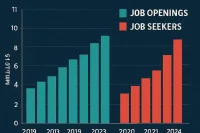US launches $20 billion financial rescue of Argentina through an unprecedented currency swap line that allows the US Treasury to directly purchase Argentine pesos, marking one of the most significant international financial interventions in recent decades. This extraordinary measure represents a rare step by US authorities to provide direct currency support, demonstrating the critical importance of maintaining financial stability across North America.
The intervention comes as Argentina faces ongoing currency instability that has been disruptive to financial markets throughout the region. Treasury Secretary Scott Bessant’s announcement that the US Treasury is prepared to take “whatever exceptional measures are warranted” underscores the seriousness of the situation and the US commitment to maintaining international financial stability.
This $20 billion rescue package represents a substantial commitment that goes beyond typical international financial assistance, reflecting Argentina’s strategic importance to regional economic stability and the broader global financial system. The direct purchase of pesos by the US Treasury is an exceptional measure that authorities rarely employ, highlighting the unique circumstances and high stakes involved.
Table of Contents
The Strategic Importance of Argentina: Beyond Day-to-Day Impact
Argentina’s economic stability has far-reaching implications that extend well beyond its immediate impact on US daily life, making it a crucial regional economic anchor. Argentina represents a much larger and richer economy than most people understand, making its financial stability crucial for regional and global economic health.
The country’s strategic position in South America, combined with its significant economic size, makes it a key player in regional trade and financial flows. Argentina’s economic health directly impacts neighboring countries and trading partners, creating ripple effects that can influence broader market stability.
The decision to provide such substantial support reflects Argentina’s importance as a regional economic anchor and trading partner. The country’s economic stability is essential for maintaining confidence in emerging markets and preventing broader financial contagion that could affect US interests and investments.
Currency Support: One of the Toughest Treasury Decisions
Currency support measures represent one of the most challenging decisions any Treasury Department must make, requiring careful analysis of multiple factors and carrying significant risks. Currency interventions require careful analysis of multiple factors and carry significant risks if not executed properly.
The US Treasury Department’s decision to proceed with this intervention reflects confidence in their analysis and the belief that the benefits of stabilizing Argentina’s currency outweigh the potential risks. The department’s expertise in international finance and currency markets provides the foundation for this complex decision.
Currency support measures are inherently risky because they involve direct intervention in foreign exchange markets, which can be unpredictable and subject to various external factors. The decision to proceed despite these risks demonstrates the US commitment to maintaining international financial stability.
Historical Precedent: Learning from Past Interventions
Historical precedent from previous currency support measures, including extraordinary actions taken during Mexico’s financial crisis, provides valuable lessons about effectiveness and risks. These past interventions provide valuable lessons about the effectiveness and risks of direct currency support.
The Mexico intervention referenced by former US Comptroller of the Currency Gene Ludwig demonstrates that such measures can be successful when properly executed. The experience gained from previous currency support operations informs the current approach to Argentina’s financial rescue.
Historical precedent also shows that early intervention, before a crisis becomes unmanageable, tends to be more effective than reactive measures. The decision to “get ahead of it” reflects lessons learned from past financial crises and currency interventions.
Learning from the Past
Historical financial interventions reveal that early, well-executed actions can stabilize economies and prevent deeper crises. Employers can apply the same principle by hiring financial experts and strategists who understand risk, timing, and execution. Post your job on WhatJobs today and connect with professionals ready to guide your business with lessons from past successes.
Post a Job Free for 30 Days →The Role of Competent Leadership in Financial Crisis Management
Under the guidance of what Ludwig describes as “competent people” who have carefully analyzed the situation from every conceivable angle, the intervention reflects quality leadership and expertise. The quality of leadership and expertise in the Treasury Department provides confidence in the decision-making process.
The complexity of international financial interventions requires not only technical expertise but also strategic thinking and political judgment. The Treasury Department’s ability to navigate these complexities while maintaining focus on long-term stability objectives is crucial for success.
Competent leadership also involves the ability to communicate effectively with markets and international partners about the rationale and expected outcomes of such interventions. Clear communication helps maintain confidence and support for the measures being implemented.
Market Stability and International Confidence
To restore financial stability and maintain international confidence in the region’s economic prospects, the intervention addresses fundamental market concerns and currency instability. Currency stability is fundamental to economic growth, trade, and investment flows that benefit all countries involved.
The intervention sends a strong signal to international markets about the US commitment to maintaining global financial stability. This signal can help prevent broader market disruptions and maintain confidence in other emerging market currencies and economies.
Market stability is particularly important for maintaining trade relationships and investment flows that benefit US businesses and consumers. A stable Argentina creates a more predictable environment for international commerce and economic cooperation.
The Mechanics of Currency Swap Lines
Through a currency swap line mechanism, the US Treasury can provide pesos directly to Argentina while receiving dollars in return, creating immediate liquidity support with appropriate safeguards. This mechanism provides immediate liquidity support while maintaining appropriate safeguards.
Currency swap lines are designed to provide temporary liquidity support during periods of market stress, allowing countries to access foreign currency without depleting their own reserves. The $20 billion amount represents a substantial commitment that should provide meaningful support for Argentina’s currency stability.
The framework allows for flexibility in implementation, enabling the US Treasury to adjust the level of support based on market conditions and Argentina’s specific needs. This flexibility is important for ensuring that the intervention remains effective throughout its implementation.
Regional Economic Integration and Stability
As part of broader efforts to maintain regional economic integration and stability across North and South America, the intervention supports interconnected regional economies. Argentina’s economic health is interconnected with the broader regional economy, making its stability important for all countries in the region.
Regional economic integration depends on stable currencies and predictable economic policies across participating countries. Argentina’s currency instability threatens this integration and could lead to broader regional economic disruption.
The US intervention helps maintain the economic relationships and trade flows that benefit all countries in the region, including the United States. A stable Argentina contributes to a more prosperous and integrated regional economy.
Driving Regional Stability
Regional economic integration depends on stability, cooperation, and forward-looking policies. Employers can contribute to growth by hiring professionals in economics, trade, and policy who understand the value of interconnected markets. Post your job on WhatJobs today and connect with candidates ready to strengthen regional prosperity and stability.
Post a Job Free for 30 Days →Risk Management and Contingency Planning
As part of a comprehensive risk management strategy that includes contingency planning for various scenarios, the intervention balances potential benefits against costs and risks. The Treasury Department’s approach includes careful consideration of potential outcomes and appropriate responses.
Risk management in international financial interventions requires balancing the potential benefits of stability against the costs and risks of intervention. The decision to proceed reflects confidence that the benefits outweigh the risks in this particular situation.
Contingency planning includes preparation for various scenarios, including both successful stabilization and potential challenges that might arise during implementation. This comprehensive approach helps ensure that the intervention can be managed effectively regardless of how events unfold.
The Future of International Financial Cooperation
As an example of how international financial cooperation can address complex economic challenges, this intervention demonstrates the importance of coordinated action in maintaining global financial stability. This intervention demonstrates the importance of coordinated action in maintaining global financial stability.
The success of this intervention could influence future approaches to international financial crises and currency support measures. The lessons learned from this experience will inform future decision-making about similar situations.
International financial cooperation is essential for addressing the complex challenges of the global economy. The US commitment to Argentina’s stability reflects recognition of this interdependence and the importance of coordinated action.
Frequently Asked Questions
What does US launches $20 billion financial rescue of Argentina mean for global markets?
US launches $20 billion financial rescue of Argentina means that the US Treasury is providing unprecedented direct currency support to stabilize Argentina’s peso, which should restore confidence in regional financial markets and prevent broader economic disruption.
How does US launches $20 billion financial rescue of Argentina compare to previous interventions?
US launches $20 billion financial rescue of Argentina represents one of the largest and most direct currency support measures in recent decades, similar to but more substantial than previous interventions like the Mexico currency support during the 1990s financial crisis.
What are the key risks and benefits of US launches $20 billion financial rescue of Argentina?
Key benefits include stabilizing regional financial markets, maintaining trade relationships, and preventing broader economic contagion, while risks include potential losses if the intervention fails and the precedent it sets for future currency support requests.
How can investors prepare for the impact of US launches $20 billion financial rescue of Argentina?
Investors can prepare by monitoring currency markets, assessing exposure to emerging market assets, diversifying portfolios, and staying informed about the progress of the intervention and its impact on regional economic stability.
A Real-World Example: Maria’s Investment Strategy
Maria Rodriguez, a 35-year-old portfolio manager from Miami, exemplifies how US launches $20 billion financial rescue of Argentina can impact investment decisions and portfolio management strategies. After the announcement, Maria had to quickly reassess her emerging market exposure and currency hedging strategies.
“I was initially concerned about the implications of such a large intervention, but the US launches $20 billion financial rescue of Argentina actually provided some stability to my emerging market positions,” Maria explains. “The intervention showed that the US is committed to maintaining regional stability, which reduced some of the uncertainty I was facing.”
Maria’s portfolio included significant exposure to Latin American markets, and the currency instability in Argentina had been creating volatility across the region. The US intervention provided a measure of stability that allowed her to maintain her positions while implementing additional hedging strategies.
“US launches $20 billion financial rescue of Argentina taught me the importance of understanding geopolitical and economic interdependencies in emerging markets,” Maria says. “The intervention demonstrated how major economic powers can influence regional stability and market confidence.”
Within three months of the intervention, Maria’s Latin American portfolio had stabilized and even shown modest gains as market confidence improved. Her experience illustrates how major international financial interventions can create both challenges and opportunities for investors navigating complex global markets.




